
Shortly after take-off I have this fine view of the large bay next to Port Blair with the Andaman Sea in the distance.
28 Dec. Chennai
To travel back to Thailand, I would have to return to the
Indian mainland, but I had a choice of going via either Kolkata or Chennai as distances
and costs are similar. With the recent visit to Kolkata under my belt, I chose Chennai
as the transit destination. This would be a good time to visit the city because
it’s now peak season for concerts of Indian classical music and dance. Also the
Northeast Monsoon that hits this corner of India from October to December would
be ending with the promise of pleasant weather.
My flight to Chennai
wasn’t scheduled to depart until a civilized 2:25 p.m., so I could have slept until
noon except for the hotel’s 8 a.m. check-out. So I packed up early and went up to
the Downtown Restaurant & Café for the usual Western breakfast. There I met
a Slovenian woman now living in Australia and traveling with her husband on a two-week
trip in the Andamans. After breakfast I stayed in the restaurant and worked on writing
and editing projects—I never run out of things to do! Rain started up and I was
glad to be under a roof. The mostly cloudy sky dried up by noon when I flagged down
an autorickshaw for the 150-rupee ride to the airport. I was early, so had time
to hit the State Bank of India ATM, then do some more writing and editing. I’ll
be flying with Jet Airways, the same airline I had recently flown from London to
Bangkok, and years ago flew the super-scenic New Delhi-Leh flight to Ladakh; all
those flights went well. I asked for a window seat and
luckily got one. Departure time for Flight 614 had changed to 3:20 p.m., so an extra
hour in the airport. The long security line went slowly, then I had a short wait
in the crowded departure area before a bus ride out to the Boeing 737-800 and the
two-hour flight to Chennai. Clouds of many types and sizes appeared abundantly and
beautifully during the first part of the flight. A short-lived rainbow flashed across
a distant downpour. About half way the clouds faded away and the plane entered a
brown haze—no mystery where the haze came from. Surprisingly the airline provided
a hot snack despite the low fare. The approach into Chennai’s airport went over
deep pits of quarries, some filled with water, then touched down as the setting
sun glowed red.

Shortly after
take-off I have this fine view of the large bay next to Port Blair with the
Andaman Sea in the distance.
My first visit to India began back in 1983 when I landed
at Chennai, then known as Madras, the capital of Tamil Nadu state. History of the
Tamil people goes far back into time, and their homeland at the southern extremity
of the subcontinent gave their culture protection from invading Muslim armies. Even
today, New Delhi and the north seem far away, and most people prefer to speak English
as a national language rather than Hindi. I liked Tamil Nadu very much, especially
the great temple complexes, on that first visit. I cycled a month in the state before
heading north on what would be a four-month ride to New Delhi. In late 2006 I came
back for another extensive ride in Tamil Nadu, seeing new places and old favorites,
www.crazyguyonabike.com/doc/asiaoneyear.
And I returned in 2011 for a backpacking trip that centered on eastern India,
https://arizonahandbook.com/indian_ramble.htm.
Chennai’s airport is good, and I heard that the new metro had just reached it. A
smooth quiet ride on the metro would be much nicer than a wild taxi ride through
heavy traffic! I followed signs to the metro terminal and bought a 50-rupee ticket
at a machine, but the metro was so new that it lacked maps and signs! One of the
staff let me photograph a map on a travel card, then pointed the way to a waiting
train. A longish ride of a dozen stops on elevated and underground tracks brought
me to Anna Nagar East station, just a short walk from the homestay I had reserved
on Booking.com. I got a large room with attached bath for 1,200 rupees/night, but
its streetside location picked up a lot of traffic noise and people chatting at
an adjacent food stall. Foreigners are a rare sight in this mainly residential neighborhood.
My phone had come back to life with internet, and my room had wi-fi. It seemed that
the phone and laptop had missed the internet more than me, as they both had a lot
of updates to download! For dinner I went across the street to a multi-cuisine café
for a malai kofta.
29 Dec. Chennai
I relaxed with reading and internet
surfing most of the day. A few blocks away on First Main Road I tried the vegetarian
Adyar Ananda Bhavan/A2B restaurant, which I liked. It’s a chain specializing in
South Indian cuisine with some North Indian and Chinese offerings plus a huge array
of Indian sweets. I loved the South Indian thali, available only mid-day. No western
breakfasts here, though I’m happy with South Indian items such as idli and masala
dosa.
30 Dec. Chennai
Compared to India’s other major metros, Chennai
has fewer sights and attracts fewer tourists, but it does have the huge Government
Museum in nearby Egmore. I took an autorickshaw
over for a visit, where entry cost 250 rupees for me and 200 for the camera. Founded
in 1851 and housed in a large complex of buildings, it’s the second oldest museum
in the country after Kolkata’s Indian Museum. I started in the Contemporary Art
Gallery, but the works on display are too old to be ‘contemporary’! Decorative art
on the lower floor includes everything from Paleolithic tools to a model of a nuclear
power plant. Fine art hung out upstairs with a few sculptures and many paintings,
including those of famed painter Raja Ravi Varma (1848–1906). The intricately carved
stone National Art Gallery next door had closed for renovations, and I skipped the
nearby Children’s Museum. I headed to the Bronze Gallery, my favorite, for dramatic
centuries-old sculptures. Shiva, his consort Parvati, and their two sons Subrahmanya
(Murugan in Tamil) and the elephant-headed Ganesa (Pillaiyar in Tamil) dominate
the mainly Hindu and South Indian collection, though Buddhist and Jain figures appear
as well. Lastly I stepped into the Main Building, a long succession of halls, where
ancient stone sculptures reside, mirroring the bronzes with mostly Hindu images
along with smaller numbers of Buddhist and Jain figures. I especially liked the
Amaravati Gallery with extensive limestone carvings from the great stupa of Amaravati
that dates back to the 3rd century B.C. Deeper into the galleries I came to the
natural history displays, disappointingly faded and dusty. Despite a whole afternoon
at the museum, I ran out of time and didn’t make it to the Anthropology Gallery,
which has musical instruments and tribal exhibits.

The venerable
Government Museum has lots of architectural embellishments.

Tipu Sultan
(1751-99), also known as the “Tiger of Mysore,” ruled the Kingdom
of Mysore
until his defeat in the Fourth Anglo-Mysore War when he was killed
while
defending his stronghold of Seringapatam, where his forces used this cannon.
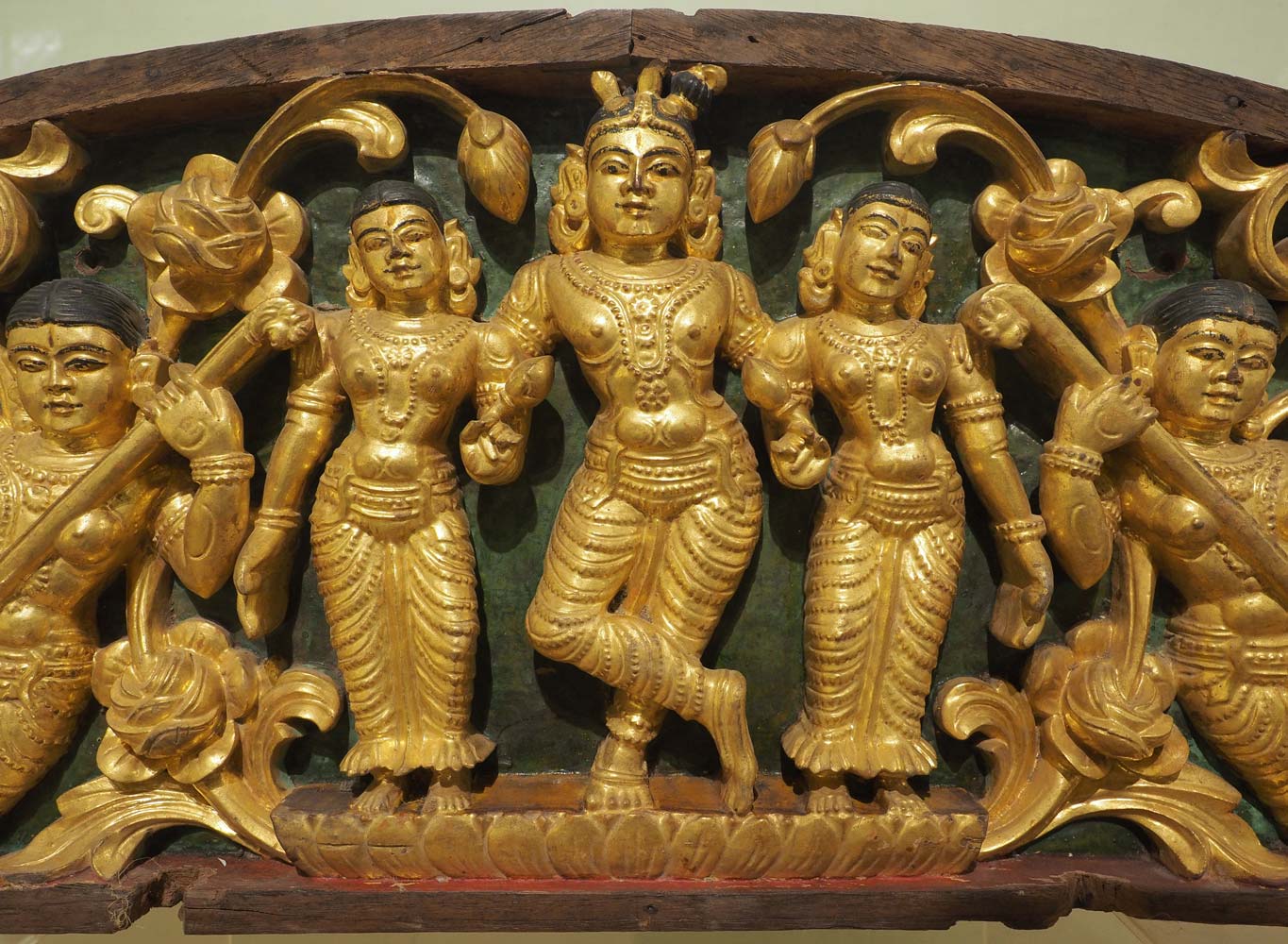
Decorative wood
carving in the Contemporary Art Gallery

A bronze Ganesh
atop his mount and flanked by two attendants

Saurashtra weavers
produced finely woven cotton kalamkari garments for the Thanjavur royal house.
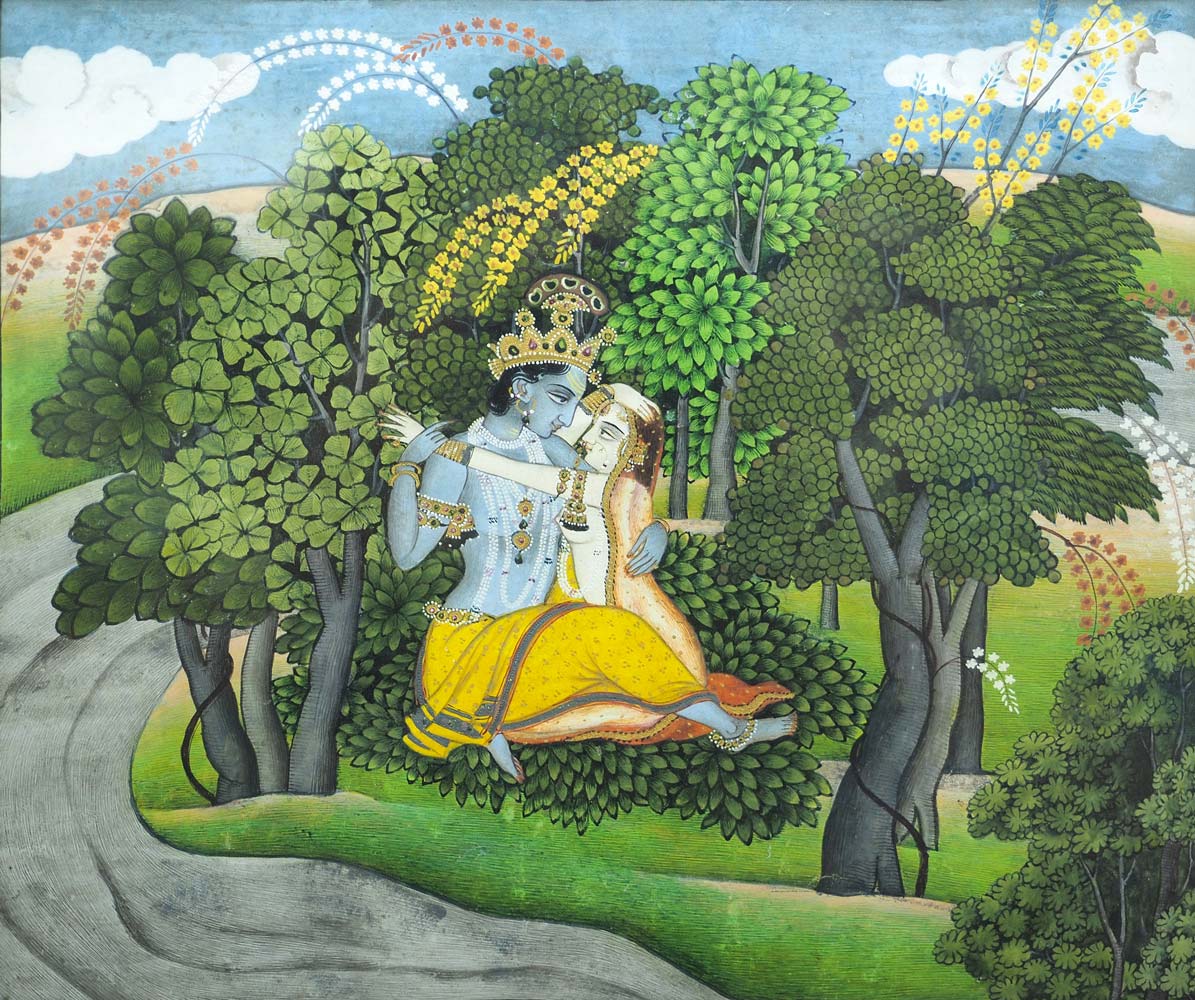
Krishna
and Radha (tempura, Kangra style)
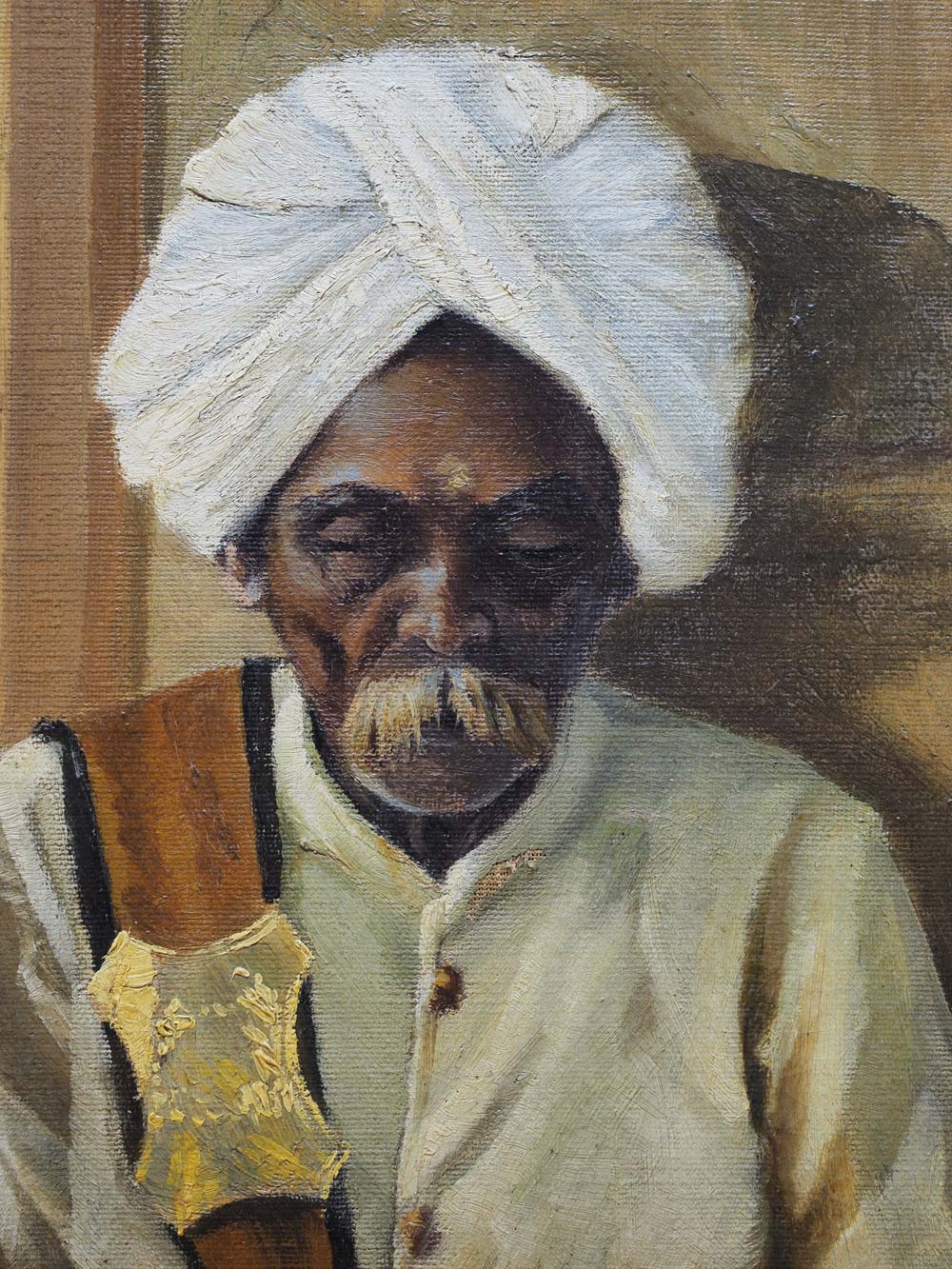
Old Peon
Enjoying a Nap (1901; oil on canvas) by Raja Ravi Varma

Crystal World
by D. Ravi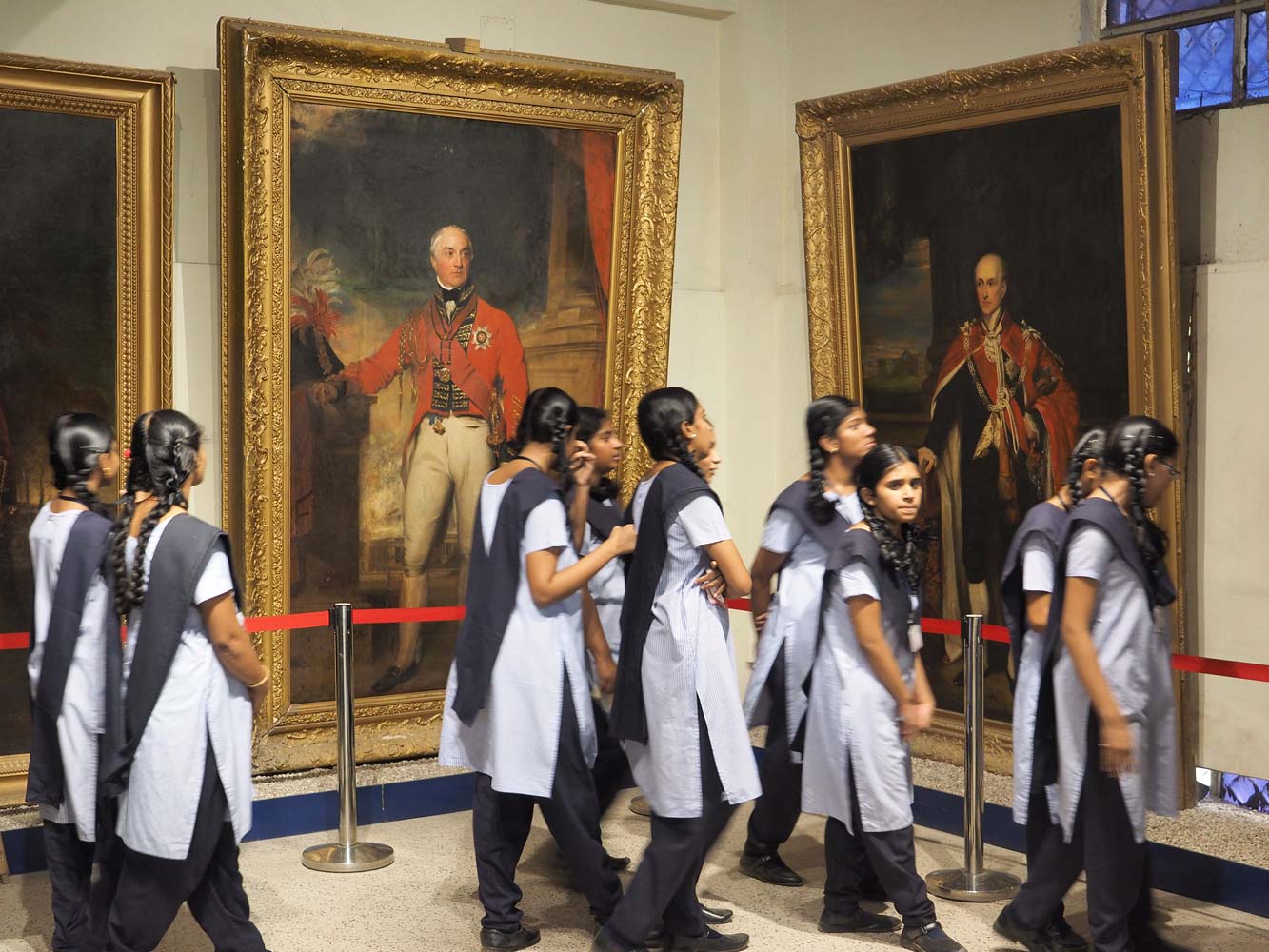
School groups seem to only march through museums with no time to stop and look.

Bronze Gallery
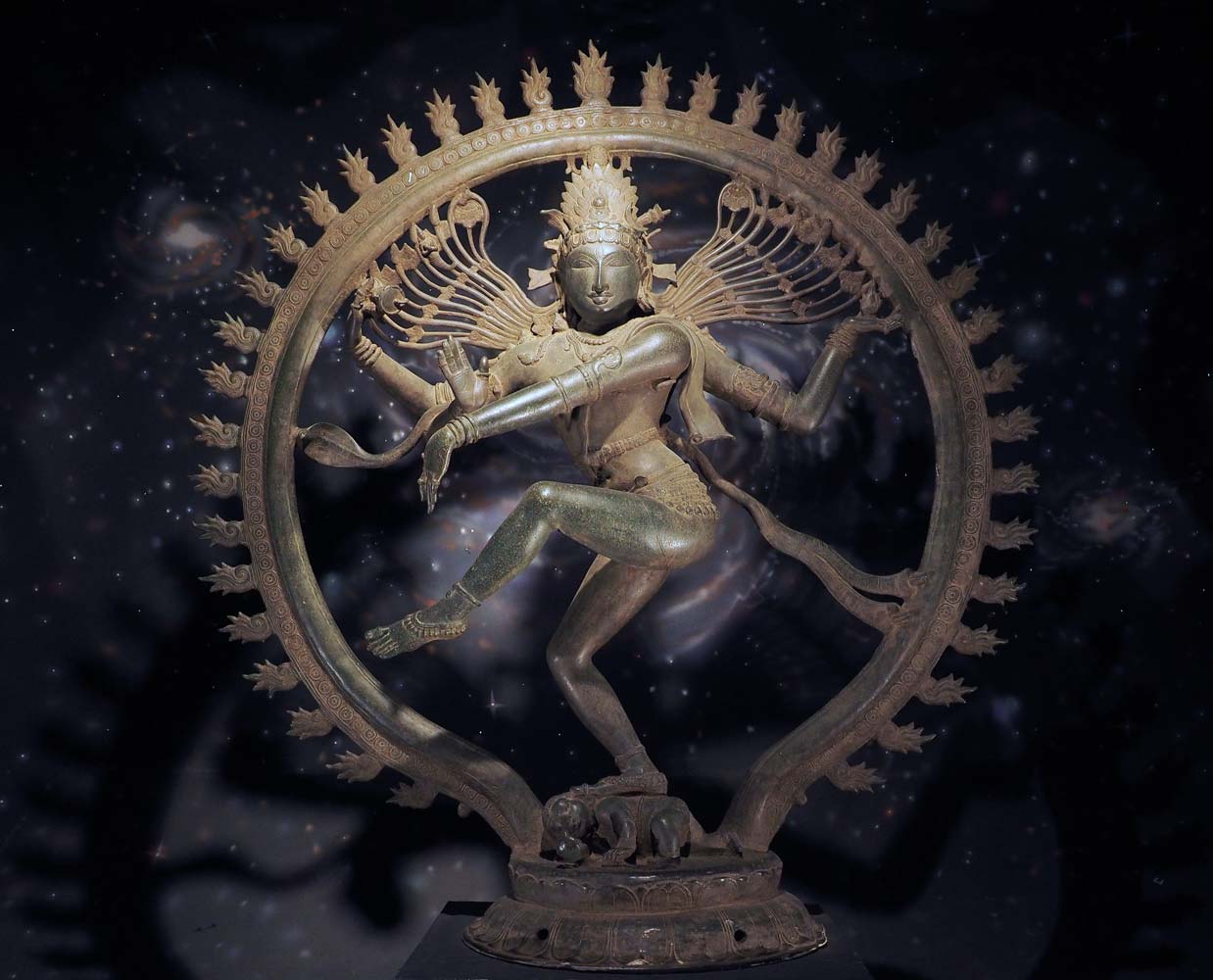
Nataraja (11th
C.; Undivided Thanjavur Distict), the Hindu god Shiva as the divine cosmic
dancer. 
Umasahita (10th C; Nagapattinam District, Tamil Nadu) depicts Shiva and Parvati.

Amaravati
Gallery
Decorative element, probably from the Great Stupa of Amaravati
I walked over to
Egmore train station, where extremely long lines at ticket windows made me glad
that I wouldn’t be traveling by train. Instead I was hoping to take the metro back
toward my homestay, but this section hadn’t opened yet. During my four weeks in
the Andamans, I never saw any newspapers or magazines for sale, but I figured there
would be newsstands near the train station, and found a couple across the street,
where I picked up The Times of India and The Hindu newspapers plus two photography
magazines. The Times is good for event listings, and I was curious about venues
for Indian classical music and dance. Lots of restaurants also stood across from
the station, but all opened to the busy street and its traffic fumes. I took an
autorickshaw back to the Ananda Bhavan restaurant for dinner.
31 Dec.
2017 Chennai
On this beautiful day of blue skies I probably should have done
something outside, but stayed in to work on writing and editing projects. As usual,
I headed to the Ananda Bhavan restaurant for South Indian food. Many people in the
neighborhood drew geometric designs called ‘kolam’ with white powder on the sidewalk
in front of their homes, and some filled in the designs with colored powders or
flower petals. A great roar of firecrackers marked the stroke of midnight at the
end of 2017! Although world politics had a great many problems over the past year,
my life and travels in Asia and Europe had gone very well.
1 Jan. 2018
Chennai
Many cultural centers have programs of Indian classical music and dance
this time of year, but the trick is to find out about them! I couldn’t find any
website that lists them all, so used the daily listings in The Times of India as
a starting point for internet searching. Today I headed to the T. Nagar part of
southern Chennai by autorickshaw for Sri Krishna Gana Sabha
https://www.krishnaganasabha.org/ and their
62nd Art Festival 2017-18. The very pretty young woman Sushmita Rajtilak performed
a Bharatanatyam dance in the small theater. Bharatanatyam, traditionally performed
solo by a woman, originated in Tamil Nadu perhaps 2,000 years ago and may be India’s
oldest classical dance form. It’s now very popular throughout the country. The dance
costume resembles that of a Tamil Hindu bridal dress with a bright colored sari
and a pleated apron. Details and photos are at
https://en.wikipedia.org/wiki/Bharatanatyam.
On the floor to her right sat two singers, a man who narrated most of the dance
and a woman who sang short fast-paced staccato passages and at other times rang
a small hand cymbal (nattuvangam). A violinist played deep mournful melodies while
a drummer used his hands to beat a double-ended mrindangam. The first dance served
as an invocation to deities, the second illustrated a story of the every-popular
god Krishna, the third depicted Shakti (goddess power), and the fourth I think was
a pure dance. A Kuchipudi dance scheduled for later in the afternoon had been cancelled,
so I went for a walk, snack, and shopping at nearby Pondy Bazaar, which includes
the large supermarket Big Bazaar, something very common in Bangkok but a rarity
in India. I returned to Sri Krishna Gana Sabha for an evening Bharatanatyam dance
called “Brihadeeswara – Form to Formless” in the larger main theater. This performance
required a ticket (200 rupees) that put me in the back rows, where seeing details
such as eye movements was more difficult; also the music was recorded. Getting back
to my homestay by autorickshaw was a challenge because drivers know locations mainly
by landmarks, and I didn’t know of any. Having my phone’s GPS is a huge help in
getting around because I can navigate and know if the driver is off course, which
happens surprisingly often!
2 Jan. Chennai
I returned to Sri Krishna
Gana Sabha, luckily with the same driver that I went with yesterday and now knew
the way. The afternoon program had two Bharatanatyam performances, with the first
having a flutist instead of a violinist and the second with a veena player. Right
after that I moved to the main auditorium for a nadaswaram concert. The nadaswaram
is a long oboe-like instrument and may be the world’s loudest woodwind! I grew fond
of it on previous trips listening in the echoing great stone halls of temples. Commonly
played in the south states of India, it’s also popular at weddings and concerts.
Three nadaswaram artists played tonight, with the central man clearly the leader.
Two men on the sides played the thavil, a drum with a larger and higher-tuned face
played with the fingers and a smaller face struck with a short stick. Harmonium
and hand-cymbal musicians played in the background. Indian musicians have great
endurance, and the concert lasted two hours. In a surprising coincidence, the same
autorickshaw driver I had ridden with this morning—and yesterday—saw me and knew
the way back to my neighborhood and the Ananda Bhavan restaurant.
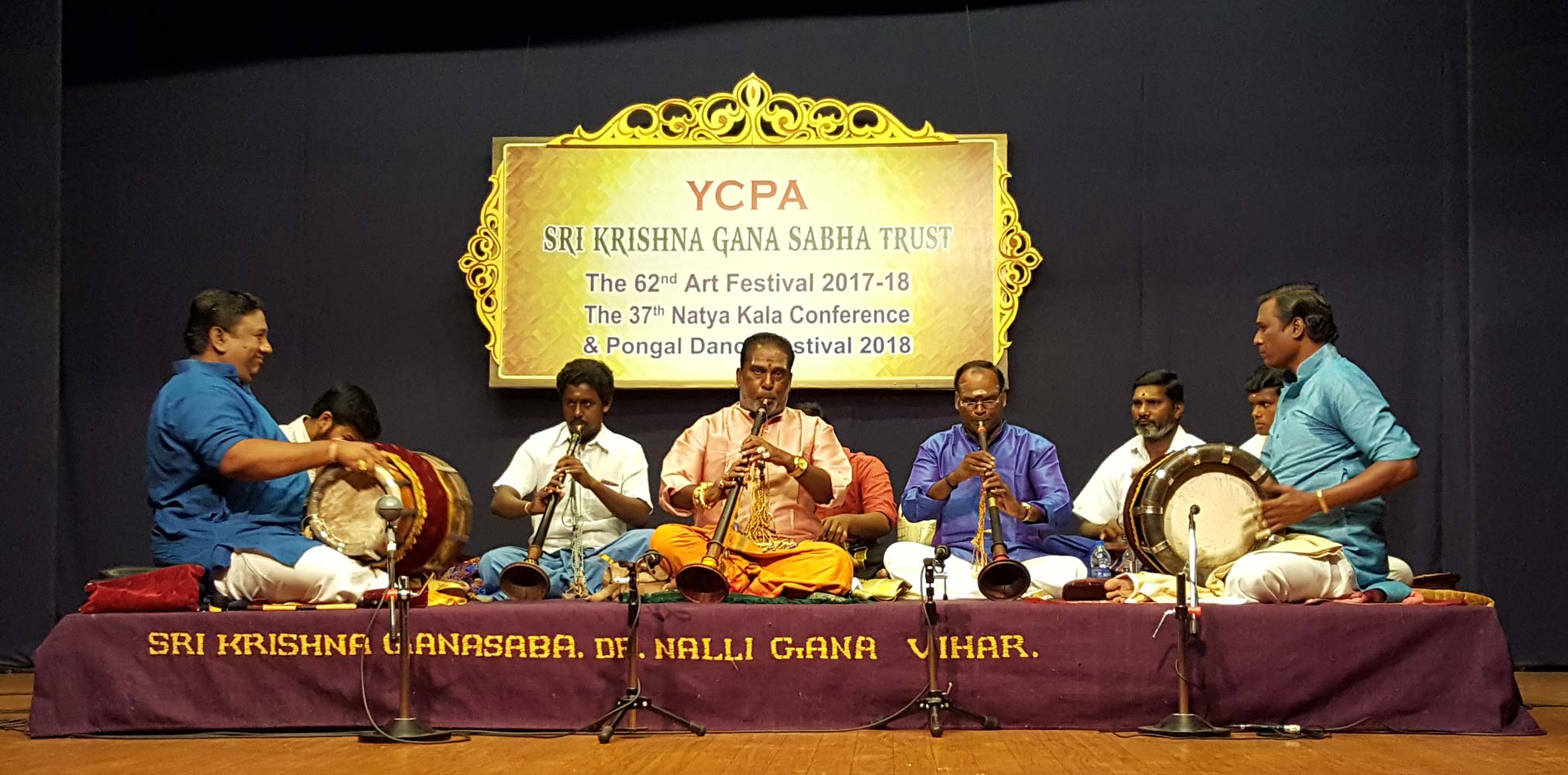
Nadaswaram
concert
3 Jan. Chennai
Today is the last day of the festival at Sri Krishna Gana Sabha,
and again the afternoon program had two Bharatanatyam performances, the first by
G. Bagya Lakshmi and the second by Sneha Chakrapani. I brought my
camera to capture some of the moments.

Musicians for
Bharatanatyam by G. Bagya Lakshmi
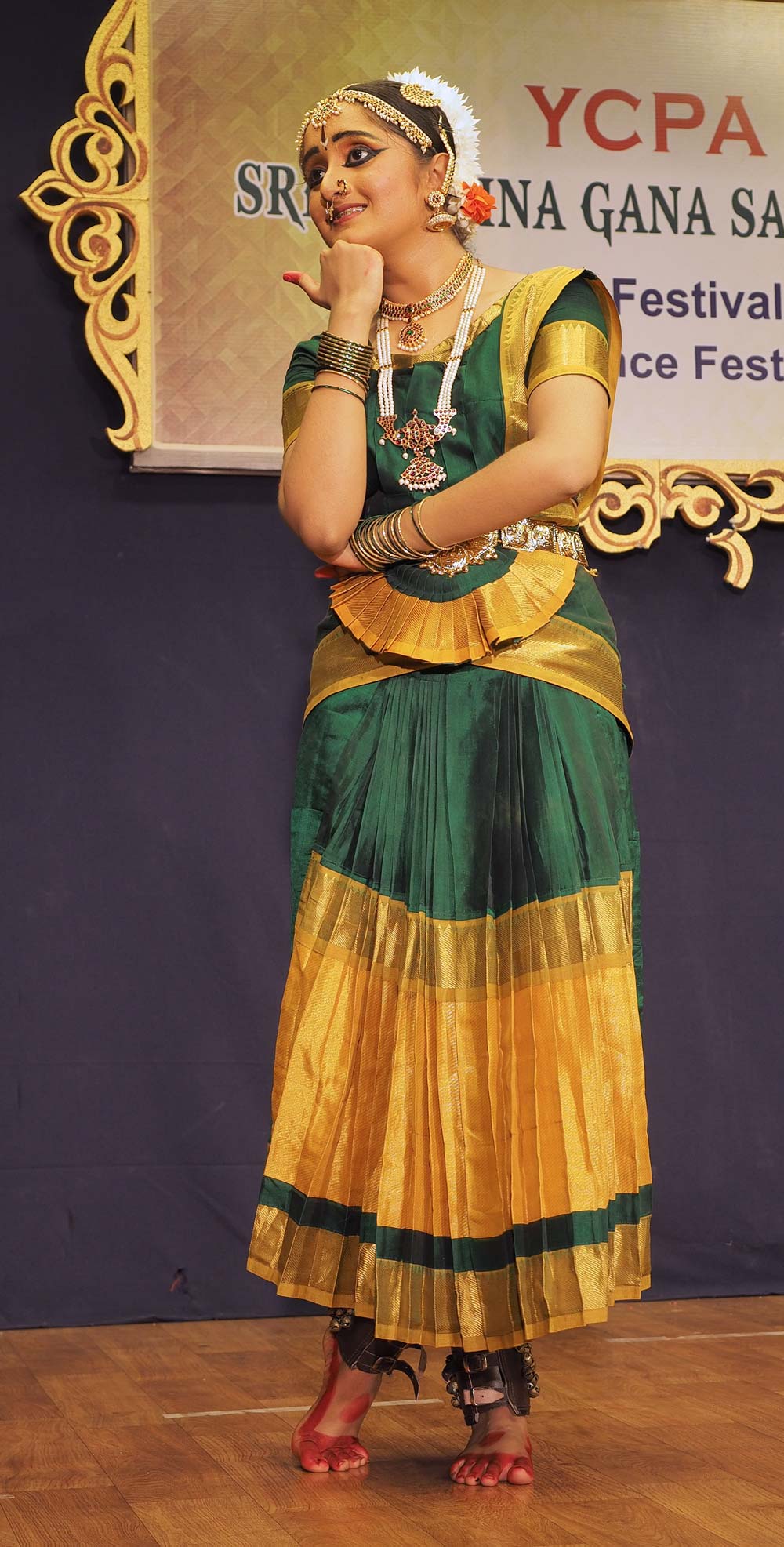
Bharatanatyam by G.
Bagya Lakshmi
Bharatanatyam by G. Bagya Lakshmi

Bharatanatyam by G.
Bagya Lakshmi
Musicians for Bharatanatyam by Sneha Chakrapani
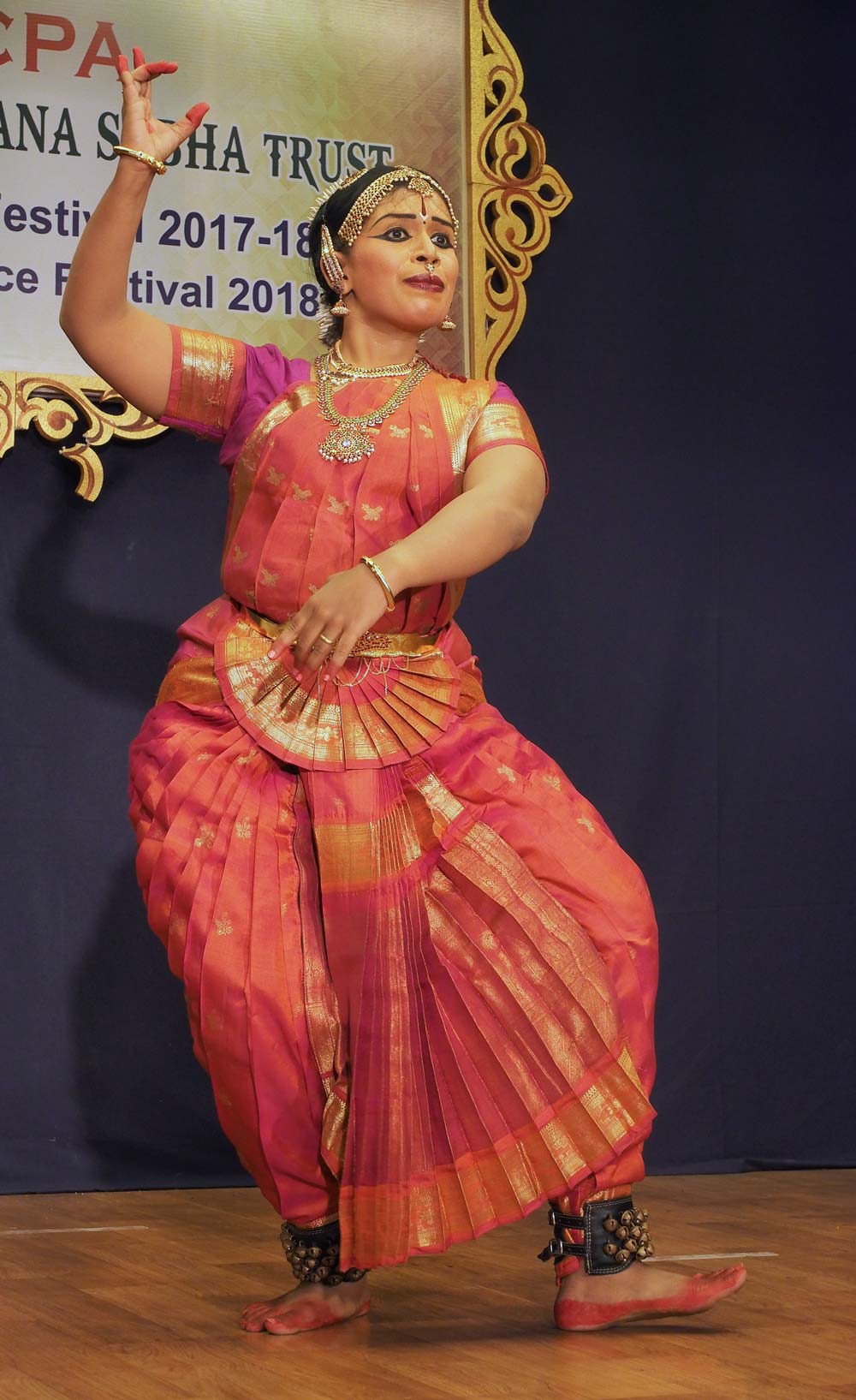
Bharatanatyam by
Sneha Chakrapani

Bharatanatyam by
Sneha Chakrapani

Bharatanatyam by
Sneha Chakrapani
A singer, K.J. Yesudas, would give the evening program, which requires a ticket, so I bought a 600-rupee ‘donor pass’ for a seat in the middle rows of the main auditorium. While the two previous nights had seen lots of empty seats, tonight had a nearly full house. A check on Google revealed that K.J. Yesudas has recorded more than 100,000 songs and performs classical, devotional, and cinematic songs in many Indian and other languages! Born in 1940, he has a long white beard yet possesses the stamina of someone decades younger. On stage, a violinist accompanied him, often with an echoing refrain. Percussion came from players of a mridangam (double-ended drum) and a ghatam (clay pot). A tanpura (long-necked string instrument) provided a continual background drone. The concert lasted three hours, with a break for solo and duet performances by the mridangam and ghatam players. Toward the end the singer took requests from an enthusiastic audience.

K.J. Yesudas and
his musicians
4 Jan. Chennai
In the afternoon I headed southeast by autorickshaw to performances of the Fine Arts Society
at Ethiraja Kalyana Nilayam in Alwarpet for what would
be the last day of its festival. Three Bharatanatyam dancers and their singers and
musicians gave fine performances. A handy restaurant adjacent to the auditorium
dished out flavorful snacks. In the evening a huge cast of youth presented a dance
drama “Shadaksharam” about a great battle between demons and Hindu gods. I thought
the demons especially cute with their large painted-on mustaches. The goddess Kali
looked fierce even if her fangs had also been painted on. And being an Indian production,
the drama had many pretty young women dancers!
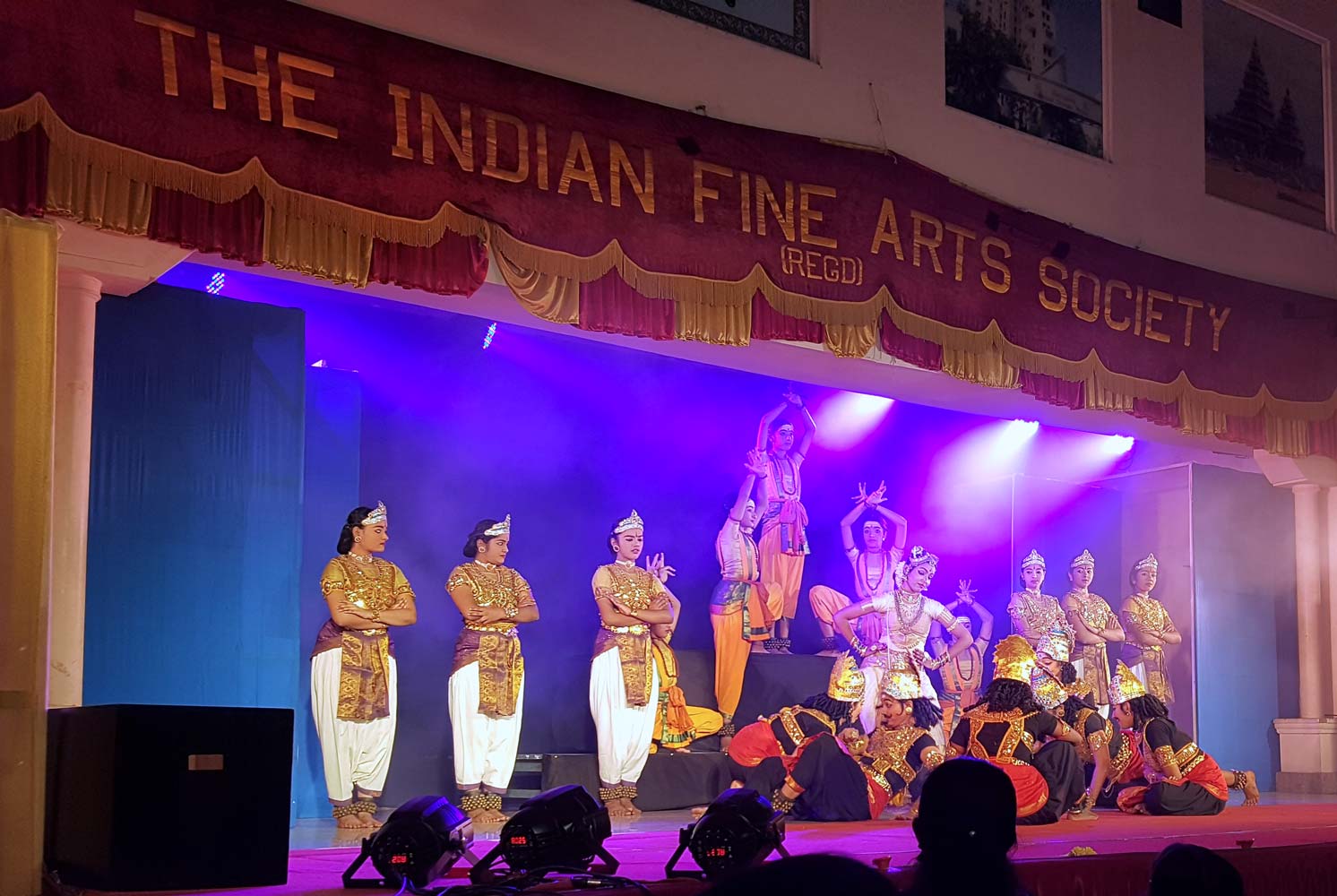
Scene from
“Shadaksharam”
5 Jan. Chennai
Today
I tried the lunchtime Special North Indian Thali at Ananda Bhavan restaurant and
found it very good, though my favorite is still the South Indian version. Afterward
I got an autorickshaw for the long ride southeast to the Mylapore Festival, held
just east of Kapaleeshwarar Temple, a large and colorful Hindu complex with an impressively
large and ornate eastern gopura (gate tower) covered in tiers of colorful statues
of gods and saints. The festival began with a pair of men on nadaswaram and another
pair on thavil drums. Although these instruments are super loud, the musicians had
a sound system to make the performance extra deafening! Next three children played
Indian music on electronic keyboards. (I’m not so fond of these instruments, but
when I visited Chennai in 2011 a group of 109 children performed on keyboards to
an appreciative audience, then a representative from the Guinness World Book of
Records presented a certificate proclaiming this the biggest concert of keyboards
ever!) Next a student group performed a high-energy Bollywood-style dance with a
central Shiva character and a large ensemble of dancing girls. Then for what I thought
the most impressive performance of the evening, folk dancers from Kerala wore enormous
headdresses, yet could still jump and spin around dramatically to the beat of their
musicians. The day’s events ended with a Villu Paatu (‘Bow Song’) concert, which
sounded very odd to my ears. It’s an ancient form of musical story-telling from
parts of Kerala and Tamil Nadu with narration interspersed by music. A woman sang
and struck a giant ‘bow’ (the age-old weapon of warriors) decorated with bells and
attached to a ceramic pot. Next to her, a man sang and struck the pot. The concert
began with a devotional song, then the woman gave a long narration punctuated by
strange vocalizations from the man. I quickly tired of this and headed into Kapaleeshwarar
Temple, a pleasant spot with many shrines and courtyards in addition to the main
central temple. People swung by the shrines and entered the temple for a blessing
from a priest or just sat in a courtyard and enjoyed the night air. Cows, looking
well cared for, inhabited a stall. I could see a Shiva lingam deep in the main temple,
though only Hindus can enter. Afterward I had tasty South Indian snacks
at a branch of Hotel Saravana Bhavan just north of the temple before heading back
to my homestay.
6 Jan. Chennai
I took a rest day and didn’t accomplish
much other than reading the news and updating this journal. For lunch I headed to
Ananda Bhavan restaurant for the wonderful Special South Indian Thali. At night
I returned for a masala dosa snack and piece of chocolate cake.
7 Jan.
Chennai
I got to work writing postcards, then strolled once again to Ananda Bhavan
restaurant for its super-tasty Special South Indian Thali. In the afternoon I caught
an autorickshaw southeast to Brahma Gana Sabha in Mylapore for a trio of beautiful
dance performances. Aarabhi Badri gave a Barathanatyam recital and, unusually, there
was a written program that briefly explained each of her dances. The first one honored
the elephant-headed god Ganesha and included the phrase (in Tamil), “With His blessings,
problems become powerless and obstacles are driven away with the mere utterance
of His name.” The second and central dance was the Nrithyopahaaram about a heroine
who asks a friend to bring her lord to her. The third dance told of foster mother
Yasoda playing with the child Krishna. In the fourth dance, a poem tells of Krishna’s
lady friend Radha, who has a fit of jealousy after being stood up by the god. Lastly,
a dance uses lively footwork and poses in praise of Krishna.
The second
performance also had fine Bharatanatyam dancing. The third performance featured
the Mohiniyattam style of dance from Kerala state. It had a slower rhythm along with
its own set of movements and gestures, most notably some lively eyebrow up and down
motions. Most dances honored Hindu gods, such as Vishnu and his man-lion incarnation
Narasimha, but one dance portrayed a lullaby with a mother and child. I finished
the day with tea and chocolate cake at Ananda Bhavan restaurant, then sent out a
Facebook posting and e-mails.
8 Jan. flight Chennai-Bangkok
The
flight to Bangkok wouldn’t depart until 10:30 p.m., so I headed over to the Music
Academy https://musicacademymadras.in/
on T.T.K. Road for two beautifully performed Bharatanatyam performances in the morning,
the first by Meera Sreenarayanan and the second by Aishwarya Balasubramaniam. Afterward
I headed over to the Pondy Bazaar area for a South Indian thali at Hotel Saravana
Bhavan, then to the post office to send off a bunch of postcards. Lots of clothing
stores line the street, and I got a new pair of dress pants. Lastly I headed to
Big Bazaar supermarket for soap and snacks to take with me to Thailand. Back at
my homestay, I retrieved the backpack and took the metro to the airport, again glad
to avoid the fumes and crazy driving that plague Chennai’s main roads. Check-in
went smoothly and I climbed onto an Airbus A320-200 for Air Asia FD 154, then headed
into the night skies over the Bay of Bengal.